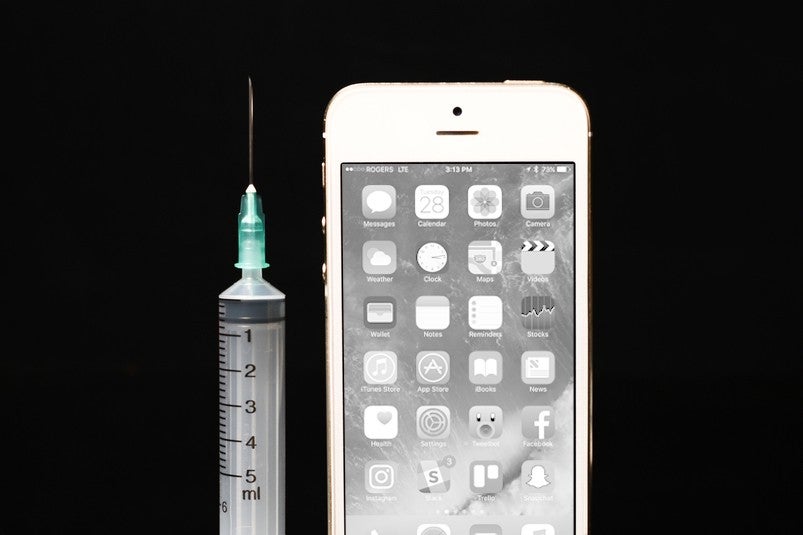Saturday night I met a friend for dinner, and he spent a portion of it extolling the virtues of switching an iPhone’s color settings to grayscale. Going black-and-white had reduced his urge to pick up his phone, tap on one of his social media apps and mindlessly scroll its feed.
The following morning, I discovered there was a New York Times trend piece about the practice starring Mack McKelvey, the CEO of marketing firm SalientMG (coincidentally, another friend).
In the not-so-distant past, fast-food chains were criticized for their liberal use of red, orange and yellow in their color schemes — colors intended to increase arousal and induce appetite in unwitting customers. Now we’re taking the opposite approach with tech companies — muting their palette of soothing blues, purples and greens with Casablanca-esque black and white.
But if we’re going to turn our phone into drab, monochromatic texting machines, then what the hell is the point of having a smartphone at all? We might as well revert to buying $50 Nokias and playing Snake.
That said, going grayscale has been life-changing for McKelvey. Just one week after implementing the change, she’d reduced the amount of time she spent on her phone by 75 percent. She’s lost interest in social media, and she spends less time playing mobile games and more time present in her own life — either focusing on her business, or paying attention to her husband.
And yet, even she concedes that grayscale isn’t ideal. McKelvey normally loves Instagram, but the app is considerably duller in black and white. And she’s not taking nearly as many photos as when her phone still functioned in color. “I don’t have a solution for the camera problem,” McKelvey tells me. “Nor do I plan to start carrying a camera around.”
What McKelvey would like instead, and what almost all of us desperately need, is the ability to toggle between different phone modes — one that, like grayscale, diminishes the time-sucking properties of a phone, and one that will allow for casual use and includes the entire color spectrum.
It’s telling that for the iPhone 8, the grayscale option is buried deep within the phone’s settings options. Apple has as little interest in curing you of your social-media addiction as Twitter, Facebook and Snapchat do. (Grayscale is easier to turn on and off on earlier iterations of the device.)
Allow me, however, to once again suggest Do Not Disturb, which allows your phone to receive texts, emails and other messages, but doesn’t buzz your phone every time you do. Rather than feeling that anxiety-inducing vibration in your pocket every time you get even the most inconsequential of notifications, you can check your phone at your own leisure and respond to any notifications accordingly. You can even customize Do Not Disturb so that you can still receive certain notifications, such as all phone calls or texts from specific contacts.
Do Not Disturb works all the better if you turn off all your Facebook, Twitter and Instagram notifications, too. At the very least, configure your notifications so they don’t ping your phone, but you see a red notification indicator in the upper-right hand corner. This will stop you from obsessively checking your phone as notifications pour in, but alert you what needs checking when you unlock your phone.
The problem here, though, is that this is a system specific to me and my unique phone habits, and even then, it’s not an elegant solution. It’s taken me many years of fine-tuning to establish a sane but workable relationship with my phone; many other people simply don’t have the meticulous nature to create their own personalized method.
Do Not Disturb doesn’t work for McKelvey, for instance. She needs to be reachable during work hours, so she feels uncomfortable about the idea of not receiving notifications for texts, calls and emails. And Do Not Disturb doesn’t even address her main issue, which is that when she opens an app, she gets too drawn in. “Being interrupted is only part of the issue,” she explains. “Do Not Disturb doesn’t reduce a person’s engagement when they’re using an app.” Certainly not the way grayscale does.
Nor is it an option to revert to a BlackBerry or some other kind of antiquated cellphone. McKelvey still uses her phone to stay up on the news, keep track of her flight and hotel reservations and navigate while driving.
What the iPhone needs is a work mode that’s distinct from personal mode. Until then, however, the onus is on users to create solutions for themselves that, ironically, make their phones less pleasant and less useful.
“I’ve tried burying my apps on page two or three of my phone, or deep within folders, but that doesn’t change my behavior — it simply makes me spend more time looking for each app, and trying to remember where I hid it,” McKelvey says. “It has to be something more radical. For some reason, removing the color has been that for me.”
